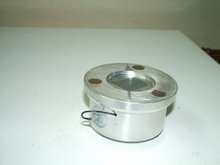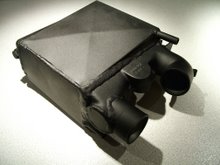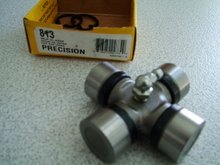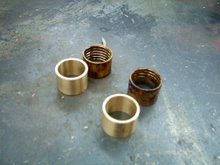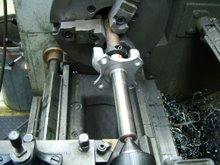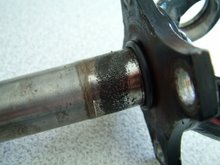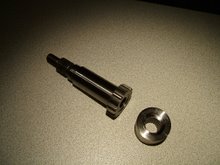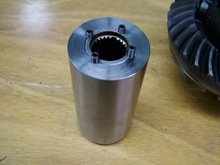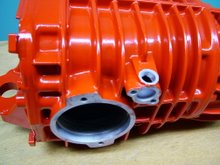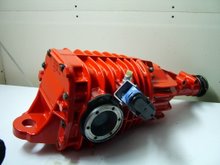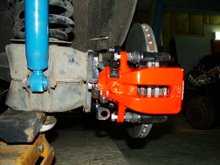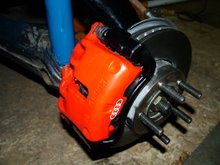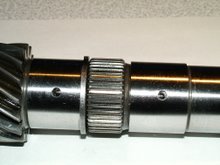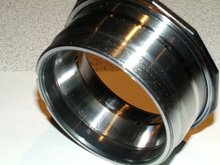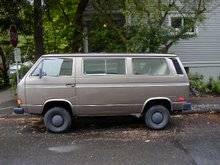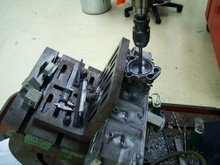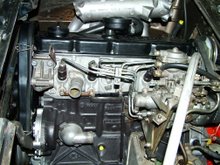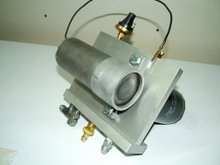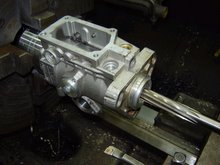The original brakes that come with the Vanagon are not very good, especially on the Syncro Westy, there is a lot of weight. There are South African Vanagon brakes that you can install, they take vented rotors but the piston size is still the same as the later type Vanagons.
I installed a set of later Audi 5000 turbo rotors with the Girling double piston calipers that came of the same car. You have to machine the caliper bracket to match the holes of the steering knuckle and use 8 mm thick spacers with M16 or 5/8 " bolts for this.
In the rear I have calipers from a 2004 Jetta VR6 or Audi A4, they take vented rotors. I have used 1985 Audi 5000 Quattro front rotors, they are 280x22mm. The calipers are mounted, by using an adaptor, to the bearing housing.
The brake hoses are from a 2004 Passat AWD, they use a banjo type bolt to connect it to the calipers.
Also, the rear hubs have to be machined down so that they fit inside the rotors. I had to go to a bigger wheel and longer studs, using 17" Audi S6 mags.
I am using synthetic brake fluid so I had to clean out all brake and clutch lines, it does't mix with regular brake fluid.
Once the van is on the road, I will check out the brakes to determine if the rear brakes lock up too easy on a wet surface, I may have to install a different pressure reducing valve.
Saturday, February 17, 2007
Transmission
When I bought the Vanagon, the seller told me that the transmission needed work, it was making grinding noises and popped out of gear.
Now the weak points of these transmissions are the 4th and 5th synchronizer body that cracks and breaks, it gets stuck in gear and is hard or impossible to get out. Also the double roller pinion bearing, main shaft bearing and 5th gear needle bearing run too hot and eventually will fail, especially if a more powerful engine is installed.
To improve the internal oiling of the bearings you can install plastic drip trays that were developed for the South African Vanagon that had a 5 cyl Audi engine, but still these tranny's absorb a lot of heat from the engine and eventually fail.
On my transmission, the synchronizer body was broken, main bearing split and housing scored.To improve the lubrication, I have drilled an oil channel through the housing to the double roller pinion bearing, cut a radial groove outside around the bearing with 3 small holes to the center of the bearing. Now it will have filtered and cooled oil pumped through the bearing center.
Also I have drilled an oil channel into the main shaft to the needle bearing cages of the 4th and 5th gears, put a spray nozzle on the main shaft bearing and one on the pinion.
External oil pressure is supplied by an extra power steering pump, that pumps the oil through an oil filter and then through a cooler into the tranny.You can see all the external pressure lines on the pictures.I hope that this will keep the tranny together for a long time.
To bring the engine revs down a bit, I have installed different 4th and 5th gears, they have nice big teeth on them, the original gears have very fine teeth and are known to fail. The new ratio's are: 1.14 : 1 third gear and 0.77 : 1 for the fourth gear.
Now the weak points of these transmissions are the 4th and 5th synchronizer body that cracks and breaks, it gets stuck in gear and is hard or impossible to get out. Also the double roller pinion bearing, main shaft bearing and 5th gear needle bearing run too hot and eventually will fail, especially if a more powerful engine is installed.
To improve the internal oiling of the bearings you can install plastic drip trays that were developed for the South African Vanagon that had a 5 cyl Audi engine, but still these tranny's absorb a lot of heat from the engine and eventually fail.
On my transmission, the synchronizer body was broken, main bearing split and housing scored.To improve the lubrication, I have drilled an oil channel through the housing to the double roller pinion bearing, cut a radial groove outside around the bearing with 3 small holes to the center of the bearing. Now it will have filtered and cooled oil pumped through the bearing center.
Also I have drilled an oil channel into the main shaft to the needle bearing cages of the 4th and 5th gears, put a spray nozzle on the main shaft bearing and one on the pinion.
External oil pressure is supplied by an extra power steering pump, that pumps the oil through an oil filter and then through a cooler into the tranny.You can see all the external pressure lines on the pictures.I hope that this will keep the tranny together for a long time.
To bring the engine revs down a bit, I have installed different 4th and 5th gears, they have nice big teeth on them, the original gears have very fine teeth and are known to fail. The new ratio's are: 1.14 : 1 third gear and 0.77 : 1 for the fourth gear.
The new engine
Labels:
Engine
I had been looking for a diesel engine to put in place of the 2.1 gas engine that comes stock in the later Vanagons. First I looked at the 1.6 and 1.9 Turbo Diesels, 1.9 TDI and 2.5 TDI.
The 1.6 TD is a bit low on power and the TDI's have too much electronics, I wanted to keep things simple, easy to repair and be able to run it on veggie oil.
I owned an Audi 5000 TD before and I really liked the 5 cylinder engine, it is based on the 1.6 TD, this engine revs fairly high, it's redline is about 5000 rpm, so this is comparable with the gas engine that it is replacing.
I started looking for one. Two months later I saw a 1983 Audi 5000 2.0 Turbo Diesel engine on Craigslist and picked it up in Olympia WA, the seller also had a SA bell housing to bolt this motor to the Vanagon Transaxle for sale for $175.00, so I bought this also.
After disassembling the engine, I found out that this engine had a lot of miles on it, I ordered 5 new pistons, had the block hot tanked and bored , rods re sized and crankshaft ground. The cylinder head had cracks between the valves, which is common, but the seats were corroded and needed to be replaced.
I milled out the cracks and welded the head, installed new seats, valve guides, valves and seals. Also, I installed a steel head gasket that is standard on the 2.4 Eurovan diesel. The head gaskets are a weak point on all early VW, Audi and Volvo diesels, so I am sure this will improve the reliability of this engine.
The Audi 5000 engine uses a vacuum pump that is bolted to the end of the cyl head to provide vacuum for the brake booster, this is driven by a belt. The problem is that it makes the engine longer and in order to set or check the injection pump timing, the pulley and belt have to be removed.
VW uses a diaphragm pump on the Eurovan diesels and it is run by a push rod that rides on a cam lobe. The whole pump is bolted to the side of the cyl head between the injectors.
I drilled all the mounting and push rod holes. So I got rid of a belt and ended up with more space in the engine compartment.
I powder coated all the sheet metal, and made a connector in the sump for an oil pre-lube pump.
Audi 5 and Volvo 6 cyl diesels have a history of engine wear during cold starts, the oil pump is located right behind the crank pulley, so it is a long way to the back of the engine.
To solve this problem, I have installed a pre-lube pump that takes oil from the crankcase, pumps it through an oil filter back into the engine. I took a 12volt pump that is normally used as backup on hydraulic brake boosters of trucks and school buses.
It is mounted on a thick aluminum plate that has internal oil passages drilled in it, I also added two VW spin on oil filters, one for engine oil and the other for transmission fluid.
The injection pump that came with this engine had a lot of shaft wear and this is probably the reason that it ended up for sale. It will suck a lot of air into the pump instead of fuel, it causes hard starts and loss of power.
It has two bushings in it that are about 3/4" apart. I made an one piece bushing out of bronze, pressed it in and machined it close to the size that it has to be, then reamed it to its final size.(17 mm on this pump)
Reseal kits are easy to get, bought mine on EBay for about $20.00, it includes all washers, O' rings and a shaft seal. It is not hard to install and should last me for years.
The 1.6 TD is a bit low on power and the TDI's have too much electronics, I wanted to keep things simple, easy to repair and be able to run it on veggie oil.
I owned an Audi 5000 TD before and I really liked the 5 cylinder engine, it is based on the 1.6 TD, this engine revs fairly high, it's redline is about 5000 rpm, so this is comparable with the gas engine that it is replacing.
I started looking for one. Two months later I saw a 1983 Audi 5000 2.0 Turbo Diesel engine on Craigslist and picked it up in Olympia WA, the seller also had a SA bell housing to bolt this motor to the Vanagon Transaxle for sale for $175.00, so I bought this also.
After disassembling the engine, I found out that this engine had a lot of miles on it, I ordered 5 new pistons, had the block hot tanked and bored , rods re sized and crankshaft ground. The cylinder head had cracks between the valves, which is common, but the seats were corroded and needed to be replaced.
I milled out the cracks and welded the head, installed new seats, valve guides, valves and seals. Also, I installed a steel head gasket that is standard on the 2.4 Eurovan diesel. The head gaskets are a weak point on all early VW, Audi and Volvo diesels, so I am sure this will improve the reliability of this engine.
The Audi 5000 engine uses a vacuum pump that is bolted to the end of the cyl head to provide vacuum for the brake booster, this is driven by a belt. The problem is that it makes the engine longer and in order to set or check the injection pump timing, the pulley and belt have to be removed.
VW uses a diaphragm pump on the Eurovan diesels and it is run by a push rod that rides on a cam lobe. The whole pump is bolted to the side of the cyl head between the injectors.
I drilled all the mounting and push rod holes. So I got rid of a belt and ended up with more space in the engine compartment.
I powder coated all the sheet metal, and made a connector in the sump for an oil pre-lube pump.
Audi 5 and Volvo 6 cyl diesels have a history of engine wear during cold starts, the oil pump is located right behind the crank pulley, so it is a long way to the back of the engine.
To solve this problem, I have installed a pre-lube pump that takes oil from the crankcase, pumps it through an oil filter back into the engine. I took a 12volt pump that is normally used as backup on hydraulic brake boosters of trucks and school buses.
It is mounted on a thick aluminum plate that has internal oil passages drilled in it, I also added two VW spin on oil filters, one for engine oil and the other for transmission fluid.
The injection pump that came with this engine had a lot of shaft wear and this is probably the reason that it ended up for sale. It will suck a lot of air into the pump instead of fuel, it causes hard starts and loss of power.
It has two bushings in it that are about 3/4" apart. I made an one piece bushing out of bronze, pressed it in and machined it close to the size that it has to be, then reamed it to its final size.(17 mm on this pump)
Reseal kits are easy to get, bought mine on EBay for about $20.00, it includes all washers, O' rings and a shaft seal. It is not hard to install and should last me for years.
Subscribe to:
Posts (Atom)



















